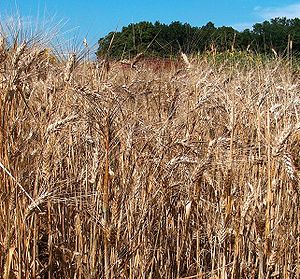Durum wheat
| Durum wheat | ||||||||||||
|---|---|---|---|---|---|---|---|---|---|---|---|---|

Durum wheat ( Triticum durum ) |
||||||||||||
| Systematics | ||||||||||||
|
||||||||||||
| Scientific name | ||||||||||||
| Triticum durum | ||||||||||||
| Desf. |
The durum wheat ( Triticum durum ), including durum , durum wheat or glass wheat named after wheat ( Triticum aestivum ), the most economically important wheat -Art. They are usually grown as summer cereals .
description
Vegetative characteristics
Durum wheat grows as an herbaceous plant and reaches heights of 80 to 150 centimeters. The stalk is thick-walled and the top with Mark met. The nodes are bare.
Generative characteristics
The annual inflorescence measures 4 to 6 centimeters without awns , with a width of 12 to 18 millimeters. It is compressed on the sides and roughly a square in cross-section. The ear axis is not brittle when ripe, so the durum wheat is a naked wheat. Tufts of hair sit at the point of attachment of the spikelets . The spikelets contain four to seven flowers, two to four of which are fertile . The spikelet is 10 to 15 millimeters long, longer than it is wide. The glumes are 9 to 12 mm long, almost as long as the lowest floret. They are membranous and keeled sharp to winged. The keel ends in an upright tooth. The side keel ends in a side tooth. The lemmas have nine to 15 nerves, are no more than 12 millimeters long and carry an awn up to 20 millimeters long.
The caryopsis is elongated-pointed. It is loosely covered by the cover and palea and falls out of the ear when it is ripe. The endosperm is glassy.
The chromosome set is allopolyploid with 2n + 2n = 28.
Durum wheat is characterized by its high gluten content , yellow color and high cooking strength. It has a higher protein content and at the same time lower starch content than winter soft wheat.
Average composition
The composition of durum wheat naturally fluctuates, both depending on the environmental conditions (soil, climate) and the cultivation technique (fertilization, crop protection).
Details per 100 g of edible portion:
|
|
|
1 mg = 1000 µg
The physiological calorific value is 1424 kJ (339 kcal) per 100 g of edible portion.
distribution
Durum wheat is only known as a culture. It probably originated from the emmer ( Triticum dicoccon ). It loves warmth and needs less than 500 mm of annual precipitation . Important growing areas are the Mediterranean and the Middle East .
Durum wheat represents around 10% of the world's wheat. The most important countries in Europe for producing durum wheat in 2007 were Italy (4 million t), France (1.9 million t), Spain (1.2 million t) and Greece (0.9 million t). In the same year, 38,000 t were harvested in Germany and 53,000 t in Austria.
The durum wheat varieties currently (2014) approved in Germany (6 winter and 10 summer durum wheat varieties ) are listed in the descriptive list of varieties of the Federal Office of Varieties .
use
Durum wheat is particularly rich in protein (average content around 16%). Elastic doughs can be obtained from the semolina or haze of durum wheat, which are particularly suitable for the production of pasta , especially classic Italian pasta . Also couscous and bulgur are made from durum wheat.
Others
In the European Union , consumption exceeds production. In order to keep the price low, there is an export duty on durum wheat - currently (as of May 2016) the only one in the EU.
Durum wheat that has been pre-cooked in steam, dried and peeled, is available under the brand name Ebly .
Web links
- Durum wheat at the National Center for Biotechnology Information (NCBI)
- Durum wheat. In: FloraWeb.de.
- Triticum durum Desf. In: Info Flora , the national data and information center for Swiss flora .
- Thomas Meyer: Data sheet with identification key and photos at Flora-de: Flora von Deutschland (old name of the website: Flowers in Swabia ).
supporting documents
- Siegmund Seybold (Ed.): Schmeil-Fitschen interactive (CD-Rom), Quelle & Meyer, Wiebelsheim 2001/2002, ISBN 3-494-01327-6 .
Individual evidence
- ↑ Ternes, Täufel, Tunger, Zobel: Food Lexicon . Behr's Verlag, Hamburg 2005, ISBN 3-89947-165-2 .
- ↑ Nutrient database of the USDA ( Memento of the original of July 18, 2013 in the Internet Archive ) Info: The archive link has been inserted automatically and has not yet been checked. Please check the original and archive link according to the instructions and then remove this notice.
- ^ A b c Wolfgang Franke: Nutzpflanzenkunde. Usable crops of temperate latitudes, subtropics and tropics. 4th edition, Thieme, Stuttgart 1989, ISBN 3-13-530404-3 , p. 82.
- ↑ Getreide-Jahrbuch 2008/2009, Ed. Verlag Moritz Schäfer, Detmold (figures from the ZMP and from national statistics).
- ↑ Descriptive list of varieties for grain, page 112 ff , accessed on August 21, 2014
- ↑ Federal Customs Administration : Basic information on customs duties and taxes in export procedures , information, accessed on March 16, 2014.
- ↑ morgenpost.de: Do you know Ebly?


